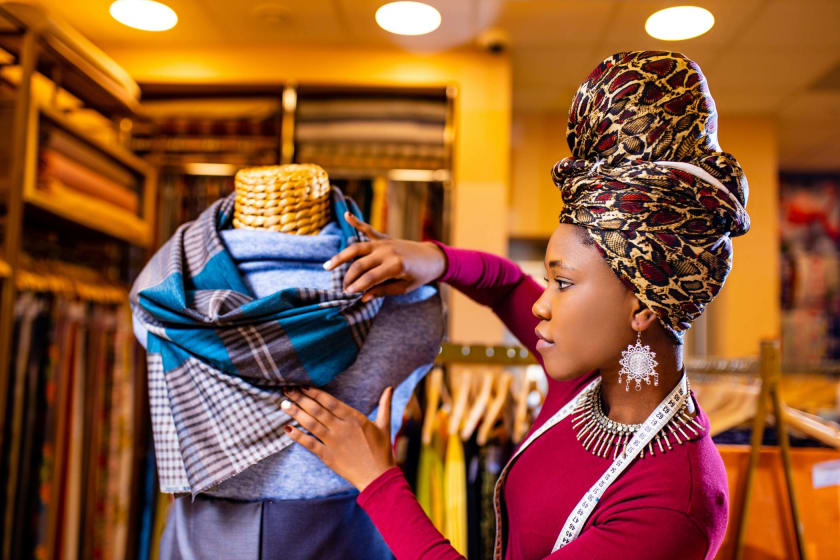Kick-start A Textile Business In The Fashion Industry



Running any business comes with a set of challenges -- finding a profitable niche, ensuring customer and employee retention, and innovating new solutions to make better products. The aftermath of the pandemic has been especially detrimental to the textile industry – Inditex (Zara-brand owner) has given up inventory worth $336 million, and Burberry, the British luxury brand, has forecast a 70% drop in sales. The global apparel market fell an estimated 22% in 2020, but is expected to grow again in 2021-22. As the pandemic recedes, there is cause for hope – India’s merchandise exports are rising along with world recovery and an increase in public consumption. There has been an uptick in both apparel and home textile consumption in the latter months of 2021. Besides, textiles are a ubiquitous part of everyone’s lives - from clothing to upholstery to coffee filters. As giants fall, there may be opportunities opening up for smaller, more flexible businesses to explore the lost space. Consider the following before kick-starting a textile business:
-Equipment and Cost Analysis
The manufacture of textiles is no mean feat. It requires major equipment such as tufting machines and power looms, and skilled workers who can operate them. On an average, a loom can cost between 3-10 lakh, and a ring spinning machine can cost up to 25 lakh. Therefore, the starting cost is high. Even smaller, more artisanal factories require a sizable initial investment. The cost will vary widely depending upon the type of fabric created – a complex jacquard weave will require more input than a plain muslin cloth. Every bit of saving on the input will translate into a better profit margin. However, investments made to ensure the quality and durability of the product tend to pay themselves back. Also, account for the cost of all the government licenses that the business will require to run legally.
The textile can be synthetic or natural or a combination, but the linearity of the traditional textile manufacturing process has been exposed as a hindrance. It is estimated that USD 500 billion is lost annually due to underutilization and the absence of recycling. Many businesses have found strength in a circular economy – recycling old polyester and plastic to make new fabric. Smaller businesses argue that this is not cost-effective on a small scale and that creating virgin material is more manageable. The cost analysis must be done thoroughly in the initial phases, allowing for large error margins to ensure that the business is profitable. A thorough research of suppliers and existing infrastructure is required. A flexible and forward-thinking business plan that is clear on the exact demand that the business intends to supply is a necessary first step.
-Target a niche – customer research

Finding a niche in the textiles market is no easy feat. With the wide range of products on offer and the varying needs of customers, the best way to find a niche is through customer research. Many surveys conducted by the industry are freely available online, such as the Textile Industry & Market Growth in India, prepared by the India Brand Equity Foundation. Further research may be done by reaching out to prospective customers directly.
Many textile manufacturers dream of working with global business giants such as Zara and H&M, or even couture houses such as Gucci or Dior, but in most cases have to start small and local. Understanding the needs of the immediate customer and filling a gap in the local economy is an essential starting point. At this stage, it is important to get a quality certification (e.g., ISO certification) to ensure that product standards assure customers. This is also an excellent time to research new and upcoming fabrics, especially vegan and organic alternatives to usual choices, which can signal that the business is forward-thinking. Recycled plastic bottles and corn fibers are already in the limelight, and many such eco-friendly alternatives are presently under research. Another example of an underutilized niche is the metal recycling industry. Metals in the textile business are required for jewelry, bags, other accessories, and sometimes for the trims of garments themselves. Finding a market gap not yet fulfilled may be a better bet than being a general producer.
Customer data is key in honing the production and the marketing approach. What do fashion and home businesses in a given area lack? Can any process be done faster, or at a superior quality? If a textile business has a specialization in a particular process, it does well to show off certifications to potential customers. Market Buyer Reports are also freely downloadable, as is the Asia-Pacific Economic Cooperation report on Indian apparel and textiles. Such reports give insight into the global status of the textile industry, the fashion houses, and their buying patterns. It is also necessary to be as well-informed on competition as possible – competitor awareness helps a business identify potential processes improvements and products absent from the present market lineup. For example, Lyocell and Tencel were introduced to the Indian market as lightweight silk alternatives and have become ubiquitous in the past decade.
-Marketing – online and offline
A good marketing strategy is essential to the success of any business. Marketing for B2B and B2C manufacturers is moving largely towards social media. Influencer campaigns are emerging as an effective marketing tool. A recent example would be Allen Solly’s #shootforsolly campaign, where 22 influencers were recorded walking through their cities in Allen Solly chinos. It generated the right buzz and actively encouraged customers to show off their favorite parts of their cities while wearing the product. The advantage of such campaigns is that they make the customer a participant rather than just an audience member. Simpler campaigns, such as Google Ads or SEO marketing, may also be tremendously successful.
However, traditional offline campaigns, such as billboards and print ads, are still popular. A recognizable logo or trademark helps. Some brand names are so popular that they have become synonymous with the product, such as Velcro and zippers (YKK). This is what every business hopes for.
A time-intensive but highly effective idea is to allow potential customers to have a factory floor tour. This will show the customer that the business is transparent in its dealings. Also, it will be an excellent time to present ethical manufacturing certifications. Another idea, which requires more effort, is to start a blog or host Q and A sessions.
It may be tempting to provide discounts to get sales started, but it can be a dangerous strategy. Many customers associate low cost with low quality. This strategy is also not sustainable, as the business will eventually have to sell at the usual price to make profits. Provide product samples instead of discounts.
-Feedback and iterative improvements

Many businesses make the mistake of being too comfortable once they reach a certain degree of success. But, in this era of constant technical advancements, it is essential to look at each component and check its efficiency proactively. It is imperative to listen to the existing customers to ensure repeat customers. Honest feedback and open communication are the only way to achieve this. Nothing beats word-of-mouth marketing and customer-written testimonials and reviews. Most sustainable businesses grow organically through a network of satisfied customers.
An underrated component of running a successful business is to know when to discontinue unsuccessful products. If a product has consistently poor customer reviews, be ruthless and discontinue. Certifications updated every few years also help. Employee education can also be a tool for the betterment of the business. A set of skilled employees is also more likely to result in a better product and less turnaround time for customers. This also breeds a sense of loyalty and helps in employee retention.
Customers respond to clarity, transparency, and sincerity. A manufacturer with a straightforward mission statement, a clear goal, and commitment to time and quality will trump any marketing trick. Communicate products’ qualities and provide solutions to existing problems. The pandemic has been a lesson in agility and adaptivity for many businesses. A significant step to kick-start a textile business would be simply listening to customers and responding to evolved needs. A bit of clever marketing doesn’t hurt. A great tool to get started is to leverage the existing infrastructure — one such step would be to reach out to Fashinza. They have a great network to connect manufacturers to fashion brands and have worked with global brands such as Forever 21 and Nykaa.



















